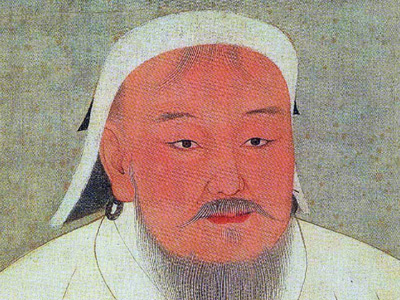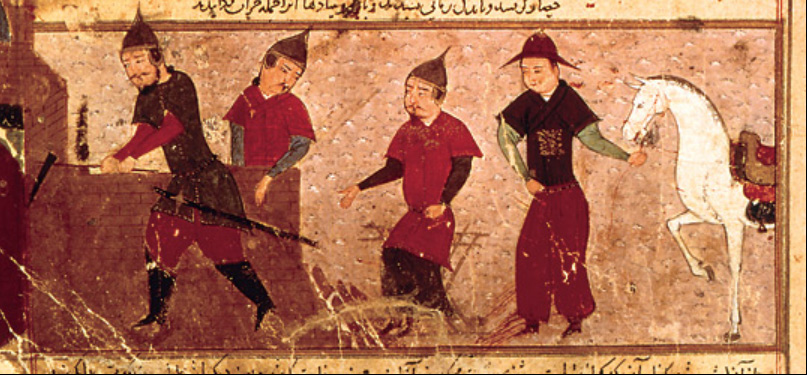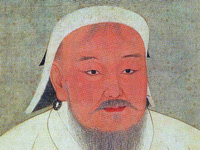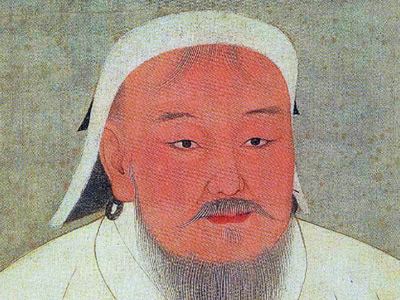Genghis Khan (1162-1227)

Death and Burial
Genghis Khan died in August 1227, during the fall of Yinchuan, which is the capital of Western Xia. The exact cause of his death remains a mystery, and is variously attributed to being killed in action against the Western Xia, illness, falling from his horse, or wounds sustained in hunting or battle. According to The Secret History of the Mongols, Genghis Khan fell from his horse while hunting and died because of the injury. He was already old and tired from his journeys. The Galician–Volhynian Chronicle alleges he was killed by the Western Xia in battle, while Marco Polo wrote that he died after the infection of an arrow wound he received during his final campaign. Later Mongol chronicles connect Genghis's death with a Western Xia princess taken as war booty. One chronicle from the early 17th century even relates the legend that the princess hid a small dagger and stabbed him, though some Mongol authors have doubted this version and suspected it to be an invention by the rival Oirads.
Years before his death, Genghis Khan asked to be buried without markings, according to the customs of his tribe. After he died, his body was returned to Mongolia and presumably to his birthplace in Khentii Aimag, where many assume he is buried somewhere close to the Onon River and the Burkhan Khaldun mountain (part of the Kentii mountain range). According to legend, the funeral escort killed anyone and anything across their path to conceal where he was finally buried. The Genghis Khan Mausoleum, constructed many years after his death, is his memorial, but not his burial site.
In 1939 Chinese Nationalist soldiers took the mausoleum from its position at the 'Lord's Enclosure' (Mongolian: Edsen Khoroo) in Mongolia to protect it from Japanese troops. It was taken through Communist-held territory in Yan'an some 900 km (560 mi) on carts to safety at a Buddhist monastery, the Dongshan Dafo Dian, where it remained for ten years. In 1949, as Communist troops advanced, the Nationalist soldiers moved it another 200 km (120 mi) farther west to the famous Tibetan monastery of Kumbum Monastery or Ta'er Shi near Xining, which soon fell under Communist control. In early 1954, Genghis Khan's bier and relics were returned to the Lord's Enclosure in Mongolia. By 1956 a new temple was erected there to house them. In 1968 during the Cultural Revolution, Red Guards destroyed almost everything of value. The "relics" were remade in the 1970s and a great marble statue of Genghis was completed in 1989.
On October 6, 2004, a joint Japanese-Mongolian archaeological dig uncovered what is believed to be Genghis Khan's palace in rural Mongolia, which raises the possibility of actually locating the ruler's long-lost burial site. Folklore says that a river was diverted over his grave to make it impossible to find (the same manner of burial as the Sumerian King Gilgamesh of Uruk and Atilla the Hun). Other tales state that his grave was stampeded over by many horses, and that trees were then planted over the site, and the permafrost also did its part in hiding the burial site.

Genghis Khan and three of his four sons. Illustration from a 15th-century Jami' al-tawarikh manuscript
Genghis Khan left behind an army of more than 129,000 men; 28,000 were given to his various brothers and his sons. Tolui, his youngest son, inherited more than 100,000 men. This force contained the bulk of the elite Mongolian cavalry. By tradition, the youngest son inherits his father's property. Jochi, Chagatai, Ögedei Khan, and Kulan's son Gelejian received armies of 4,000 men each. His mother and the descendants of his three brothers received 3,000 men each.
HISTORY

RESOURCES
This article uses material from the Wikipedia article "Genghis Khan (1162-1227)", which is released under the Creative Commons Attribution-Share-Alike License 3.0.
© Stories Preschool. All Rights Reserved.









